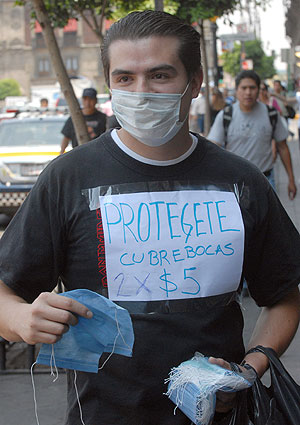
By DAN CHILDS
ABC News Medical Unit
The Kansas Department of Health and Environment has confirmed at least two cases of swine flu in the state, while the New York City Department of Public Health reported at least eight out of an estimated 100 students at a Queens prepatory school who displayed flu-like symptoms likely have the infection.
Meanwhile, Imperial County health officials reported that San Diego has yet another case of the swine flu strain that has killed up to 68 people in Mexico.
The escalation in the swine flu situation on Saturday underscored concerns by international, federal and local health agencies over the threat of the new virus, even as government health officials said much remains unknown.
But if one thing is clear about the spread of this virus, it is that containment is no longer an option.
"It's clear that this is widespread," said Dr. Anne Schuchat, director of the CDC's National Center for Immunization and Respiratory Diseases, at a press conference Saturday afternoon.
"We do not think that we can contain the spread of this virus," Schuchat added. "Having found virus where we have found it, we are very likely to find it in other places. ... We are not at a point where we can keep this virus in just one place."
The cases further demonstrate that health officials do not know where else the virus might turn up. Details of swine flu's spread in Mexico also remain murky. A team sent by the Centers for Disease Control and Prevention is now on the ground there seeking clues on the origin and spread of the disease.
What also remains unclear is why the virus seems to have led to more severe illness in Mexico than in the U.S. -- at least for now.
"What we still don't know is how widespread it is," said Dr. William Schaffner, chairman of preventive medicine at Vanderbilt University Medical Center in Nashville, Tenn. "The question is: How long have things been going on in Mexico, and how attentive have they been in terms of what's going on in their country?"
Meanwhile, emergency departments in affected areas are preparing for what they said could be a rise in cases.
"It is quite conceivable that it could escalate fairly rapidly," said Dr. Richard Bradley, chief of the Division of EMS and Disaster Medicine at the University of Texas Health Sciences Center at Houston. "If we are seeing a flu epidemic in Mexico, we should expect an uptick fairly quickly in Texas, where I am, and in California."
Emergency Departments Make Swine Flu Preparations
Still, Bradley said that the situation thus far has been relatively fortunate.
"Right now, we are in the increased awareness phase -- we don't yet know how this is going to develop," he said. "Fortunately, right now the cases in California and in Texas seem to be milder than the cases we've seen in Mexico. We hope that this trend continues in the U.S."
Emergency departments in other areas of the country also are stepping up efforts to control the virus should it surface.
Another question that remains is whether health agencies reacted quickly enough to the initial reports of swine infections in Mexico, first reported in mid-March.
"I think that the laboratory testing capabilities for this type of virus were not fully in place and this accounts for some of the delay," said Dr. Pascal James Imperato, dean of the Graduate Program in Public Health at SUNY Downstate Medical Center in Brooklyn, N.Y. "They were not routinely testing for this type of influenza virus."
Still, other infectious disease experts said that there should have been quicker action. Dr. Lewis Goldfrank, professor and chairman of the Department of Emergency Medicine at Bellevue Hospital in New York City said that though no cases have been detected in his emergency department yet, any patient who comes in with a cough and a fever or a rash and a fever is isolated for a nasal swab to detect influenza -- a test that takes about an hour.
The possible outbreak in the New York area suggests the measures may be warranted.
New York City Health Commissioner Dr. Thomas Frieden said in a statement on Saturday that more than 100 students at St. Francis Prepatory School in Queens have reported flu-like symptoms including headaches, upset stomachs and dizziness. The Health Department subsequently encouraged all of the affected students to get tested for the flu, and there are now eight probable cases of swine flu.
Currently, the CDC is performing additional tests to determine whether swine flu indeed is the culprit, according to the statement.
"Most of the patients reported mild symptoms. No child was hospitalized or seriously ill," the statement read. "The CDC results should be available by Sunday. If the results are positive -- the Health Department will recommend that the school close on Monday."
Concern over the outbreaks have reached the highest levels of the federal government, as well.
White House press secretary Robert Gibbs said that the president has been briefed and is "being kept up-to-date" in the swine flu situation.
The Homeland Security Council, under the leadership of terrorism czar John Brennan, is heading up the administration's efforts to handle the situation and is working with the CDC, the State Department and the Mexican government.
"The president will continue to get updated on what's going on, as will Brennan ... and others in the government, as the situation develops," Gibbs said.
I concur that the 'one-month lag' between case identification and reporting was too long," said Ed Hsu, associate professor of Public Health Informatics at the University of Texas School of Health Information Sciences and School of Public Health. "[It is a] good thing that the CDC now decides to have a daily briefing on the swine flu, but it will still need to bring the transparency of reporting in other high-risk countries up to speed on this."
And despite the actions by the World Health Organization with regard to the swine flu outbreaks, no decision has yet been made to increase the pandemic threat level from its current status of phase 3 to phase 4 on the six-point scale. A virus isn't considered to be pandemic until it reaches phase 6.
WHO did announce, however, that it has sent a team of experts to Mexico to further study the outbreaks.
Still Too Early to Worry?
Despite the action being taken by national and international health organizations, some infectious disease experts say it is far too early to fear the worst -- a global flu pandemic.
"The current swine flu only marginally meets only one of three of pandemic tests: effective person-to-person transmission," Hsu said, adding that the other tests -- susceptibility and no natural immunity or vaccine -- remain to be satisfied.
Hsu further noted that compared to the H5N1 strain of the avian flu virus -- commonly known as bird flu -- the current H1N1 swine flu strain is still a relative lightweight. Since 2003, he said, bird flu has garnered a 60 percent case fatality rate, and it never attained pandemic status. Meanwhile, the current swine flu strain still has fewer than 1,000 reported cases and only about 60 fatalities to its name.
"If not [a pandemic] then, why now?" he asked.
"It would be an Olympic sprint for vaccine manufacturers, starting today" to have a usable vaccine ready even by October, he said.
"If this is a virus that is sufficiently new -- and that has not been entirely determined yet -- we may need two doses of the vaccine to get protection," Schaffner said. "That, of course, would put additional strain on the vaccine production and delivery services."
Huma Khan and Michelle Schlief contributed to this report. Sphere: Related Content
![Validate my Atom 1.0 feed [Valid Atom 1.0]](valid-atom.png)










































































